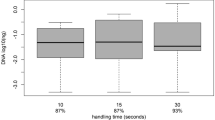Abstract
The relevance and not merely the presence of one’s DNA at a crime scene has become the emerging issue in courtrooms all over the world today. By studying the length of time DNA is likely to persist in an environment until detection, a more holistic assessment of DNA evidence in the context of a case can be made. The current study looks at the persistence of DNA from blood, keratinocytes, and several types of mock exhibits under various conditions, in the tropical rainforest climate of Singapore. While DNA on articles left outdoors showed highly variable persistence subject to the presence of rainfall, DNA from items placed indoors at ambient temperature and under controlled temperature and humidity is comparatively stable. The information gathered from this study, while not exhaustive, serves to provide investigators and the courts with a better understanding of the relevance of DNA recovered from crime scenes of different environmental conditions.





Similar content being viewed by others
References
Raymond JJ, van Oorschot RAH, Gunn PR, Walsh SJ, Roux C (2009) Trace evidence characteristics of DNA: a preliminary investigation of the persistence of DNA at crime scenes. Forensic Sci Int Genet 4:26–33
Kenna J, Smyth M, McKenna L, Dockery C, McDermott SD (2011) The recovery and persistence of salivary DNA on human skin. J Forensic Sci 56:170–175
van Oorschot RAH, Glavich G, Mitchell RJ (2014) Persistence of DNA deposited by the original user on objects after subsequent use by a second person. Forensic Sci Int Genet 8:219–225
Meakin GE, Butcher EV, van Oorschot RAH, Morgan RM (2015) The deposition and persistence of indirectly-transferred DNA on regularly-used knives. Forensic Sci Int Genet Suppl Ser 5:e498–e500
Szkuta B, Ballantyne KN, van Oorschot RAH (2017) Transfer and persistence of DNA on the hands and the influence of activities performed. Forensic Sci Int Genet 28:10–20
Pfeifer CM, Wiegand P (2017) Persistence of touch DNA on burglary-related tools. Int J Legal Med 131:941–953
National Environment Agency: Weather & Climate. http://www.nea.gov.sg. Accessed 21 Feb 2018
Feine I, Shpitzen M, Roth J, Gafny R (2016) A novel cell culture model as a tool for forensic biology experiments and validations. Forensic Sci Int Genet 24:114–119
Verdon TJ, Mitchell RJ, van Oorschot RAH (2013) The influence of substrate on DNA transfer and extraction efficiency. Forensic Sci Int Genet 7:167–175
Frégeau CJ, De Moors A (2011) Competition for DNA binding sites from denim dyes using the Promega DNA IQ™ paramagnetic beads. Forensic Sci Int Genet Suppl Ser 3:e29–e30
Frégeau CJ, De Moors A (2012) Competition for DNA binding sites using Promega DNA IQ™ paramagnetic beads. Forensic Sci Int Genet 6:511–522
Lund S, Dissing J (2004) Surprising stability of DNA in stains at extreme humidity and temperature. In: Progress in forensic genetics: international congress series 10. vol 1261. Elsevier, pp 616–618
Meteorological Service Singapore: Climate of Singapore. http://www.weather.gov.sg. Accessed 19 Mar 2019
Goray M, Mitchell RJ, van Oorschot RAH (2010) Investigation of secondary DNA transfer of skin cells under controlled test conditions. Legal Med 12:117–120
Goray M, Eken E, Mitchell RJ, van Oorschot RAH (2010) Secondary DNA transfer of biological substances under varying test conditions. Forensic Sci Int Genet 4:62–67
Steensma K, Ansell R, Clarisse L, Connolly E, Kloosterman AD, McKenna LG, van Oorschot RAH, Szkuta B, Kokshoorn B (2017) An inter-laboratory comparison study on transfer, persistence and recovery of DNA from cable ties. Forensic Sci Int Genet 31:95–104
Acknowledgments
This work was supported by the Health Sciences Authority of Singapore. The authors would like to thank all volunteers for their contribution to this study and to Professor Birgit Lane of the Institute of Medical Biology, Agency for Science, Technology and Research (A*STAR), Singapore, for providing the source material of anonymized keratinocytes.
Author information
Authors and Affiliations
Corresponding authors
Ethics declarations
Conflict of interest
The authors declare that they have no conflict of interest.
Research involving human participants
All procedures performed involving human participants were in compliance with ethical standards.
Informed consent
Informed consent was obtained from all participants in the study.
Additional information
Publisher’s note
Springer Nature remains neutral with regard to jurisdictional claims in published maps and institutional affiliations.
Rights and permissions
About this article
Cite this article
Lee, L.Y.C., Wong, H.Y., Lee, J.Y. et al. Persistence of DNA in the Singapore context. Int J Legal Med 133, 1341–1349 (2019). https://doi.org/10.1007/s00414-019-02077-2
Received:
Accepted:
Published:
Issue Date:
DOI: https://doi.org/10.1007/s00414-019-02077-2




